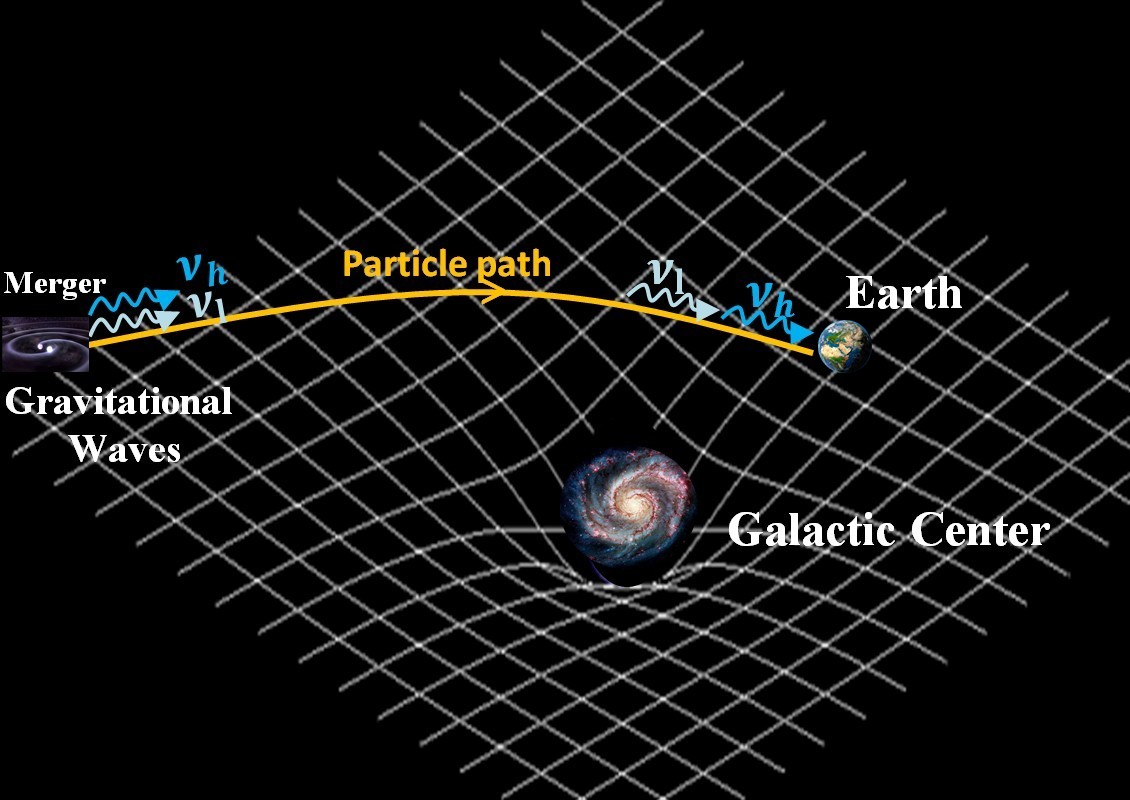Einstein’s weak equivalence principle (WEP) is the foundation of general relativity as well as of many other metric theories of gravity. In the parametrized post-Newtonian (PPN) formalism, each gravity theory incorporating the WEP is specified by a set of PPN parameters (e.g., the parameter γ which denotes the level of space curvature by unit rest mass), which predicts that the parameter γ should be the same for any two different species of massless (or negligible rest mass) neutral particles, or any two particles of the same species with different frequencies (i.e., where the subscripts stand for two different particles). Hence, the WEP accuracy can be described by constraints on the differences of the γ values for different particles through the Shapiro time delay effect (see Fig. 1).

Figure 1. A cartoon picture shows how two GW signals, one at a high frequency and another at a low frequency, travel in curved space-time from their origin in a distant extragalactic transient until reaching the Earth. A lower-limit estimate of the gravitational pull that the GWs experience along their way is given by the mass in the center of the Milky Way.
To date, only three WEP tests with different species of messenger particles have been obtained, and moreover these tests were limited to the photon and neutrino sectors. New multimessenger signals exploiting different emission channels with high significance (e.g., GWs and photons/neurtinos) are essential for further testing the WEP to a higher accuracy level. Very recently, the LIGO-Virgo team reported the first detection of a new kind of gravitational-wave event (GW170817), which arises from a binary neutron star merger. Moreover, the EM counterparts of GW170817, such as the short gamma-ray burst SGRB 170817A and a macronova within the nearby galaxy NGC 4933, are firmly detected by the follow-up observations. This is the first time in history that gravitational and EM waves from a single astrophysical source have been identified. Based on this first truly GW/EM association, we demonstrate that new, multimessenger WEP tests can be carried out by using the arrival time delays between the GW signals from GW170817 and the photons from SGRB 170817A or the macronova. Attributing the time delays to the gravitational potential of the Milky Way, we set stringent limits on the differences of the PPN parameter values for two cases, i.e., for the GW170817/macronova, and for the GW170817/SGRB 170817A. If the time delays are mainly caused by the gravitational potential of the Virgo Cluster, much more severe constraints can be achieved, implying for GW170817/macronova, and for GW170817/SGRB 170817A.The results from GW170817/SGRB 170817A provide the tightest limit to date on the WEP through the relative differential variations of the γ parameter for two different species of particles, namely , which is 7 orders of magnitudes tighter than that placed by the neutrinos and photons firmly detected from SN 1987A, and is as good as or is animprovement of 6 orders of magnitude over the limits obtained by the low-significance neutrinos correlated with GRBs and a blazar flare.
The work by Jun-Jie Wei, Bin-Bin Zhang, Xue-Feng Wu, He Gao, Peter Mészáros, Bing Zhang, Zi-Gao Dai, Shuang-Nan Zhang, and Zong-Hong Zhu has been published in Journal of Cosmology and Astroparticle Physics.
Please see JCAP, 11, 035 (2017) for more details(doi.org/10.1088/1475-7516/2017/11/035).

